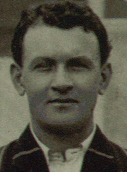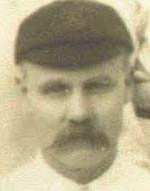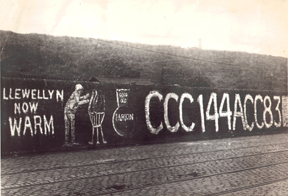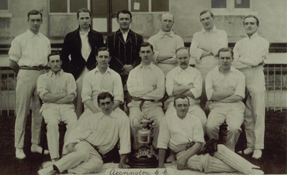|
Latest
|
|
|
Llewellyn at Accrington 90 years on

The
first overseas professionals, Australians Alex Kermode and E.B. Dwyer,
had signed for Bacup and Rawtenstall respectively in 1910, both having
previously played county cricket, Kermode at Lancashire and Dwyer with
Sussex. Accrington's signing of South African all rounder Llewellyn in
1911 was nothing short of sensational.
A
forcing left handed batsman and an orthodox slow left armer who mastered
the googly thus becoming the first bowler in England to bowl the 'Chinaman'
with any degree of regularity, Llewellyn was also a brilliant fielder
particularly at silly mid off where he took some amazing catches. Up to
this point, he had played 10 of his 15 Tests for South Africa. From 1899
until 1910, Llewellyn had played for Hampshire, scoring 1,000 runs in
a season five times and taking 100 wickets in a season four times. In
1901, 1908 and 1910 he completed the double and on two occasions he scored
two centuries in a match.
Photo of Llewellyn
in action
At
34 years of age could Llewellyn, a modest unassuming person and an excellent
coach, bring a first Lancashire League title to Accrington? In his time
with the club he would score 6276 runs at 32.2 and take 979 wickets at
10.4 between 1911 and 1925 in two spells as professional, broken by the
First World War and resumed in 1921. He scored ten centuries for Accrington
and he also took 100 wickets in a season six times.
|
Llewellyn's
Record at Accrington
|
||||||||||
|
Inns
|
N.O.
|
H.S.
|
Runs
|
Av.
|
O
|
M
|
Runs
|
Wkts
|
Av
|
|
| 1911 |
20
|
4
|
135*
|
768
|
48.0
|
333
|
56
|
1081
|
85
|
12.7
|
| 1912 |
25
|
3
|
100
|
581
|
26.4
|
387.5
|
66
|
1031
|
112
|
9.2
|
| 1913 |
25
|
3
|
188*
|
729
|
33.1
|
366
|
61
|
1040
|
101
|
10.3
|
| 1914 |
22
|
3
|
91
|
700
|
36.8
|
364
|
64
|
964
|
96
|
10.0
|
| 1915 |
22
|
4
|
129*
|
733
|
40.7
|
336
|
69
|
889
|
107
|
8.3
|
| 1921 |
25
|
4
|
100
|
603
|
28.7
|
353.2
|
87
|
961
|
74
|
13.0
|
| 1922 |
24
|
3
|
135*
|
666
|
31.7
|
388
|
63
|
1198
|
111
|
10.8
|
| 1923 |
22
|
0
|
55
|
378
|
17.2
|
433.5
|
75
|
1048
|
106
|
9.9
|
| 1924 |
23
|
3
|
55
|
470
|
23.5
|
428.5
|
71
|
1029
|
102
|
10.1
|
| 1925 |
24
|
0
|
105
|
648
|
27.0
|
373.6
|
72
|
961
|
85
|
11.3
|
| Total |
232
|
27
|
188*
|
6276
|
32.2
|
3763.7
|
684
|
10202
|
979
|
10.4
|

Accrington's
main rivals were Church and the derby matches between the two teams were
fiercely contested. Fast bowler Cecil Parkin, the first bowler to take
100 Lancashire League wickets in a season, was Church's professional during
this period. The quality of the respective professionals merely heightened
the rivalry between the two camps. A tradition, thought to have begun
in 1892, was the
The
following season, 1913, Llewellyn etched his name in the league record
books. On Wednesday July 16th Accrington entertained Bacup in a mid week
match. The home side batted first with Australian professional Alex Kermode
opening the bowling for Bacup. Llewellyn came to the crease at the fall
of the second wicket to join his captain Billy Brown. Dropped on 15, Llewellyn
set about the bowling, cutting and driving 31 boundaries (there were no
six hits then) being particularly severe on Kermode to set a new league
record score of 188 not out, a record that would stand for 24 years. He
dominated a sixth wicket stand of 154 with Arnold Chadwick before Brown
declared on 288 - 5, a total that is still a club record today. Kermode
finished with 1 - 105. When Bacup batted Llewellyn took 5 - 64 but the
visitors managed to hang on for a draw. Llewellyn's performances against
Bacup were quite astonishing:
|
Home
|
Away
|
|||
|
1912
|
100
|
9
- 23
|
92*
|
6
- 42
|
|
1913
|
188*
|
5
- 64
|
83
|
5
- 52
|
|
1914
|
18
|
7
- 23
|
50*
|
6
- 45
|
|
1915
|
39
|
7
- 27
|
16
|
6
- 8
|
 The
addition of George Parker from Haslingden and the emergence of young players
such as Johnny Pollard made Accrington a real force to be reckoned with
and in 1914, the club finally captured the Lancashire League Championship.
The signing of Parker was a real bonus. The left handed attacking batsman
was once reputedly described by the great Sydney Barnes as 'the most dangerous
batsman he had bowled against.' Parker was the first batsman, amateur
or professional to score 1,000 runs in a season and Pollard would become
in 1916, the only Accrington amateur to take over 100 wickets in a season.
The
addition of George Parker from Haslingden and the emergence of young players
such as Johnny Pollard made Accrington a real force to be reckoned with
and in 1914, the club finally captured the Lancashire League Championship.
The signing of Parker was a real bonus. The left handed attacking batsman
was once reputedly described by the great Sydney Barnes as 'the most dangerous
batsman he had bowled against.' Parker was the first batsman, amateur
or professional to score 1,000 runs in a season and Pollard would become
in 1916, the only Accrington amateur to take over 100 wickets in a season.|
Lancashire
League Final Table 1914
|
|||||
|
Pl
|
W
|
D
|
L
|
Pts | |
| Accrington |
26
|
16
|
8
|
2
|
40 |
| Todmorden |
26
|
14
|
8
|
4
|
36 |
| Colne |
26
|
14
|
5
|
7
|
33 |
| Church |
26
|
10
|
10
|
6
|
30 |
| Rawtenstall |
26
|
9
|
12
|
5
|
30 |
| Burnley |
26
|
11
|
5
|
10
|
27 |
| Haslingden |
26
|
8
|
10
|
8
|
26 |
| East Lancashire |
26
|
6
|
14
|
6
|
26 |
| Rishton |
26
|
9
|
8
|
9
|
26 |
| Ramsbottom |
26
|
9
|
6
|
11
|
24 |
| Enfield |
26
|
6
|
9
|
11
|
21 |
| Bacup |
26
|
3
|
10
|
13
|
16 |
| Nelson |
26
|
4
|
8
|
14
|
16 |
| Lowerhouse |
26
|
2
|
9
|
15
|
13 |
Not content with winning the title once, Accrington actually won again in 1915 and in 1916 this time without Llewellyn as no professionals were allowed due to the First World War.
Accrington's 1914 Championship Winning Team
Llewellyn's second spell at the club was not as successful as the first. Ormerod and Parker retired and support bowlers Pollard and Alec Jackson had turned professional. The great man was still capable of playing big innings and taking 100 wickets in a season, which he did on a further three occasions but by 1925, Llewellyn was 48 years old and at the end of the season he left to join Radcliffe in the Bolton League, scoring 3,189 runs and taking 670 wickets in seven seasons for his new employers.
Llewellyn
carried on in the leagues until he was 62 years of age.
Adapted from Golden
Moments, History of Accrington Cricket Club by Nigel Stockley
